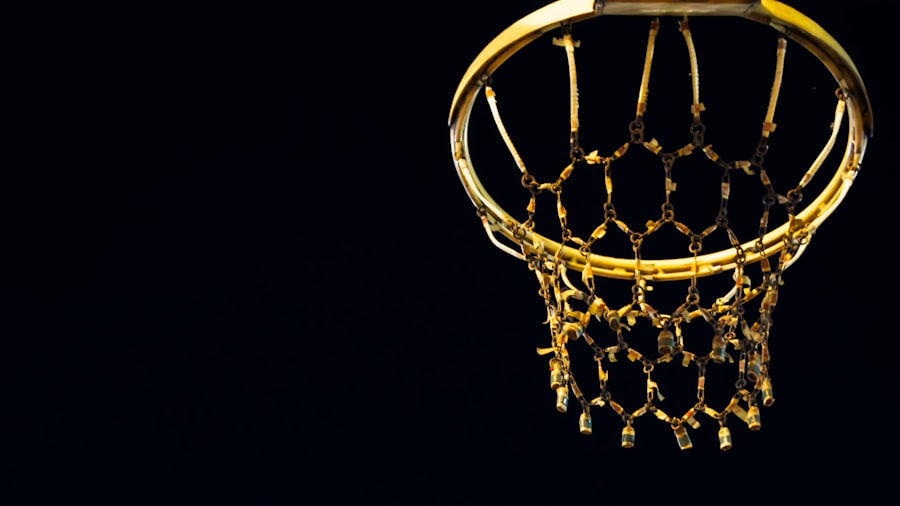The National Basketball Association (NBA) has established itself as a global powerhouse not only in sports but also in marketing. The league’s marketing strategies are multifaceted, designed to engage a diverse audience while promoting the sport and its players. The NBA has adeptly navigated the complexities of modern marketing, utilizing a blend of traditional and innovative approaches to reach fans across various demographics.
This strategic marketing framework has allowed the league to maintain its relevance and expand its influence beyond the basketball court. At the heart of the NBA’s marketing success is its ability to adapt to changing consumer behaviors and technological advancements. The league has embraced digital transformation, recognizing that fans today consume content differently than in previous decades.
By leveraging data analytics, social media, and partnerships with global brands, the NBA has crafted a marketing strategy that resonates with both local and international audiences. This article delves into the various components of the NBA’s marketing strategies, highlighting how they have effectively built a brand that transcends sports.
Key Takeaways
- The NBA focuses on strong brand partnerships to enhance its market presence.
- Social media and digital platforms are key tools for engaging fans worldwide.
- Player personalities are leveraged to create relatable and compelling marketing campaigns.
- The league targets global markets to expand its international fan base.
- Data-driven tactics and innovative merchandise help optimize marketing effectiveness.
Building Strong Brand Partnerships
One of the cornerstones of the NBA’s marketing strategy is its ability to forge strong partnerships with leading brands across various industries. These collaborations not only enhance the league’s visibility but also create mutually beneficial opportunities for both the NBA and its partners. For instance, partnerships with global corporations like Nike and Gatorade have allowed the NBA to tap into extensive marketing resources while providing these brands with a platform to reach millions of basketball fans worldwide.
The NBA’s partnership with Nike, which began in 2017, has revolutionized the league’s apparel and merchandise offerings, creating a cohesive brand identity that resonates with fans. Moreover, the NBA has successfully engaged in cross-promotional campaigns that leverage the strengths of its partners. For example, during the NBA All-Star Weekend, brands often launch exclusive products or campaigns that coincide with the event, drawing attention from both basketball enthusiasts and casual viewers.
This synergy not only amplifies brand awareness but also enhances the overall fan experience. By aligning itself with reputable brands, the NBA has solidified its position as a leader in sports marketing, demonstrating how strategic partnerships can drive growth and engagement.
Leveraging Social Media and Digital Platforms

In an era where social media dominates communication, the NBA has emerged as a frontrunner in utilizing these platforms to connect with fans. The league’s presence on platforms like Twitter, Instagram, TikTok, and YouTube is not merely about broadcasting game highlights; it is about creating a dialogue with fans. The NBA’s social media strategy focuses on delivering engaging content that encourages interaction, such as polls, behind-the-scenes footage, and player interviews.
This approach fosters a sense of community among fans, making them feel more connected to the league and its players. The NBA has also capitalized on the rise of digital content consumption by producing original programming tailored for online audiences. Shows like “The Jump” and “NBA Rooks” provide fans with insights into player journeys and expert analysis, further enhancing their engagement with the league.
Additionally, the NBA’s use of live streaming on platforms like Facebook and Twitter allows fans to access games and events in real-time, catering to a generation that values immediacy and convenience. By embracing digital platforms, the NBA has not only expanded its reach but also transformed how fans interact with basketball.
Creating Engaging Fan Experiences
| Metric | Description | Typical Value | Importance |
|---|---|---|---|
| Fan Engagement Rate | Percentage of fans actively interacting with content or events | 30% – 60% | High |
| Average Event Attendance | Number of fans attending live or virtual events | 5,000 – 50,000 | High |
| Social Media Interaction | Likes, shares, comments per post related to fan experiences | 1,000 – 20,000 | Medium |
| Fan Satisfaction Score | Average rating from fan surveys on experience quality | 4.0 – 4.8 (out of 5) | High |
| Repeat Attendance Rate | Percentage of fans attending multiple events or experiences | 40% – 70% | High |
| Merchandise Purchase Rate | Percentage of fans buying merchandise during or after events | 15% – 35% | Medium |
| Average Time Spent | Average duration fans engage with content or events | 30 – 90 minutes | Medium |
The NBA recognizes that fan engagement extends beyond watching games; it encompasses creating memorable experiences that resonate with supporters. The league has invested heavily in enhancing the in-arena experience for fans attending games. From state-of-the-art arenas equipped with high-definition screens to interactive fan zones featuring games and activities, the NBA aims to create an immersive environment that captivates attendees.
For instance, during playoff games, teams often host pre-game festivities that include live music, food vendors, and meet-and-greet opportunities with players or mascots. Furthermore, the NBA has embraced technology to elevate fan experiences through initiatives like augmented reality (AR) and virtual reality (VR). These technologies allow fans to engage with their favorite teams and players in innovative ways.
For example, AR applications enable fans to view player statistics or replays by simply pointing their smartphones at specific areas within the arena. Such initiatives not only enhance the live game experience but also create lasting memories that fans associate with their loyalty to the league.
Utilizing Player Personalities for Marketing
The NBA’s marketing strategy heavily relies on its players’ personalities, recognizing that athletes are not just competitors but also influential figures who can shape brand narratives. Players like LeBron James, Stephen Curry, and Kevin Durant have transcended their roles as basketball players to become global icons. The league capitalizes on this by featuring players prominently in marketing campaigns, allowing their unique stories and personalities to resonate with fans.
For instance, LeBron James’ “More Than an Athlete” campaign highlights his activism and philanthropic efforts, showcasing how athletes can impact society beyond sports. Moreover, player-driven content has become a significant aspect of the NBA’s marketing strategy. Social media accounts managed by players often provide fans with an authentic glimpse into their lives off the court.
This personal connection fosters loyalty among fans who feel they know these athletes on a deeper level. The NBA encourages players to share their stories through various platforms, creating a narrative that humanizes them and strengthens their bond with supporters. By leveraging player personalities effectively, the NBA has created a marketing ecosystem where athletes become ambassadors for both their teams and the league as a whole.
Targeting Global Markets

The NBA’s vision extends far beyond North America; it actively seeks to engage global markets where basketball is gaining popularity. The league has made significant strides in international outreach through initiatives like the Basketball Without Borders program and hosting preseason games in countries such as China and Mexico. These efforts not only promote basketball but also cultivate a global fan base that transcends geographical boundaries.
The NBA recognizes that basketball is a universal language, and by tapping into international markets, it can expand its reach exponentially. Additionally, the NBA has localized its marketing strategies to cater to diverse cultures and preferences. For instance, during the 2019-2020 season, the league launched a campaign called “NBA China,” which featured localized content tailored specifically for Chinese audiences.
This approach included collaborations with local influencers and celebrities to create relatable content that resonates with Chinese fans. By understanding cultural nuances and preferences, the NBA effectively positions itself as a global brand while maintaining relevance in local markets.
Implementing Data-Driven Marketing Tactics
In today’s data-driven world, the NBA leverages analytics to inform its marketing strategies effectively. By analyzing fan behavior and preferences through various data sources, including social media interactions and ticket sales patterns, the league can tailor its campaigns for maximum impact. For example, data analytics can reveal which types of content resonate most with specific demographics, allowing the NBA to create targeted marketing initiatives that speak directly to those audiences.
Moreover, data-driven insights enable the NBA to optimize its advertising strategies across different platforms. By understanding which channels yield the highest engagement rates or conversion rates for merchandise sales, the league can allocate resources more efficiently. This analytical approach extends to ticket pricing strategies as well; by analyzing demand patterns for specific games or events, teams can adjust pricing dynamically to maximize revenue while ensuring accessibility for fans.
The integration of data analytics into marketing tactics exemplifies how modern technology can enhance decision-making processes within sports organizations.
Innovating with Merchandise and Apparel Lines
Merchandising is a vital component of the NBA’s marketing strategy, serving as both a revenue stream and a means of brand promotion. The league has consistently innovated its merchandise offerings to keep pace with changing consumer preferences. Collaborations with fashion designers and streetwear brands have resulted in unique apparel lines that appeal to younger audiences seeking stylish ways to express their fandom.
For instance, partnerships with brands like Mitchell & Ness have led to retro-inspired jerseys that tap into nostalgia while attracting new fans. Additionally, the NBA has embraced sustainability in its merchandise initiatives by introducing eco-friendly apparel lines made from recycled materials. This move aligns with growing consumer demand for environmentally conscious products while reinforcing the league’s commitment to social responsibility.
The introduction of limited-edition merchandise during special events or collaborations creates a sense of exclusivity that drives demand among collectors and enthusiasts alike. By continuously innovating its merchandise offerings, the NBA not only generates revenue but also strengthens its brand identity in an increasingly competitive market. Through these multifaceted marketing strategies—ranging from building strong brand partnerships to leveraging player personalities—the NBA has successfully positioned itself as a leader in sports marketing on a global scale.
Each component of its strategy works synergistically to create an engaging experience for fans while driving growth for the league itself. As consumer behaviors continue to evolve in an ever-changing landscape, the NBA remains committed to adapting its marketing approaches to ensure sustained relevance and success in the future.



